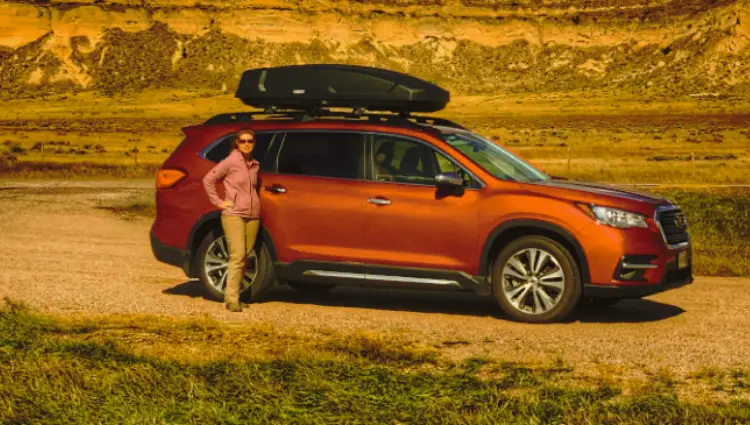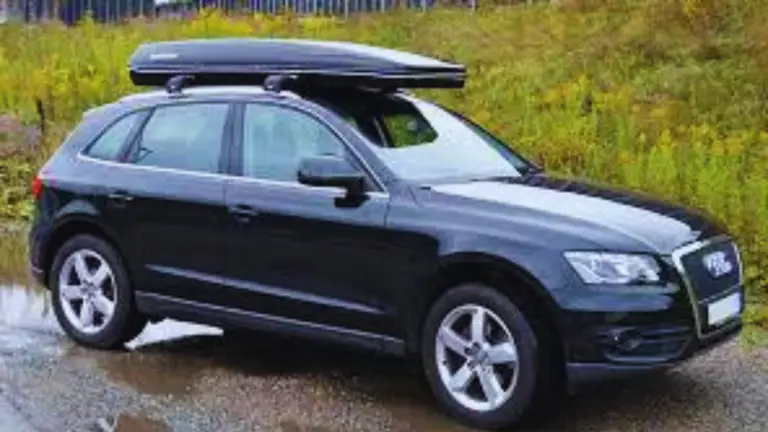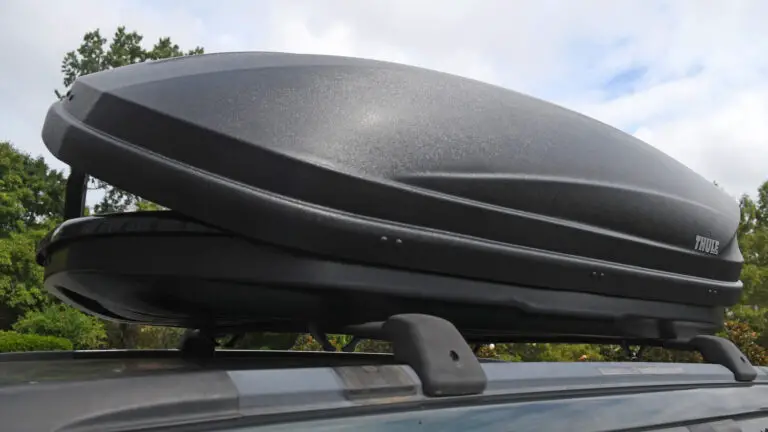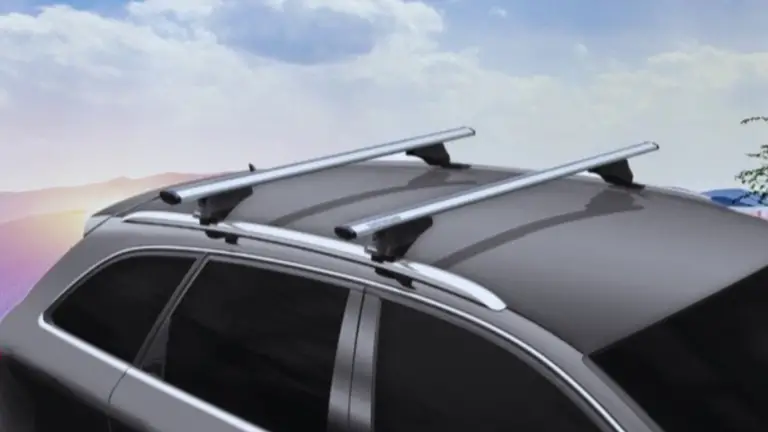Roof Top Tent Questions and Answers: Get all the answers you need about roof top tents with our comprehensive Q&A guide. Explore common inquiries, get expert advice, and make an informed decision for your next outdoor adventure.
Rooftop tents have exploded in popularity among overlanding enthusiasts and campers who love the convenience of portable lodging on their vehicle roof. But for newbies exploring the world of rooftop camping, there are some key questions to consider before taking the plunge.
In this definitive guide, we’ll answer the most frequently asked questions about roof top tents to help you determine if they are the right gear investment for your adventures.
What Exactly Is a Rooftop Tent?
A roof top tent, also known as an RTT, is a type of tent that is specifically designed to be mounted on the roof rack system of your vehicle. It allows you to have a comfortable and elevated sleeping space while camping or overlanding.
A rooftop tent (RTT) is a hard- or soft-shelled tent that mounts directly onto your vehicle’s roof rack. Most fold out into a mattress platform and an interior living space. High-quality roof top tents are designed to withstand all weather conditions and terrain while stowing securely during transport.
RTTs ride high above the ground, keeping you safely elevated from the elements. Setting up takes just minutes compared to a ground tent. When not in use, the low-profile tents fold into compact, aerodynamic cases.
In short, rooftop tents deliver portable, all-terrain shelter and sleeping capacity right on your vehicle roof!
Why Buy a Rooftop Tent?
Rooftop tents offer some unique advantages over regular ground tents:
Convenience
- Set up and break down in 1–5 minutes! No wrestling with tent poles is required.
- Saves prep time compared to clearing rocks, grass, and finding a flat campsite.
- An elevated sleeping platform means no annoying crawlers can reach you.
Comfort
- Foam mattresses are often included for better sleep.
- Stand up inside many models with ample headroom.
- Stay off wet, cold, or muddy ground.
Protection
- Tents attach securely to roof rack for safety in wind/rain.
- Locking doors and zippered screens keep bugs and critters out.
- High-quality canvas and rainflies buffer extreme weather.
Mobility
- Bring lodging with you anywhere your vehicle can reach!
- Drive to perfect campsites off the beaten path.
- Wake up to epic views without packing up camp.
Storage
- Keep all gear safely stowed and handy inside the tent.
- Vestibules and interior pockets keep items organized.
For overlanders and adventurers wanting a literal home on wheels, rooftop tents check all the boxes.
What Types of Rooftop Tents Are Available?
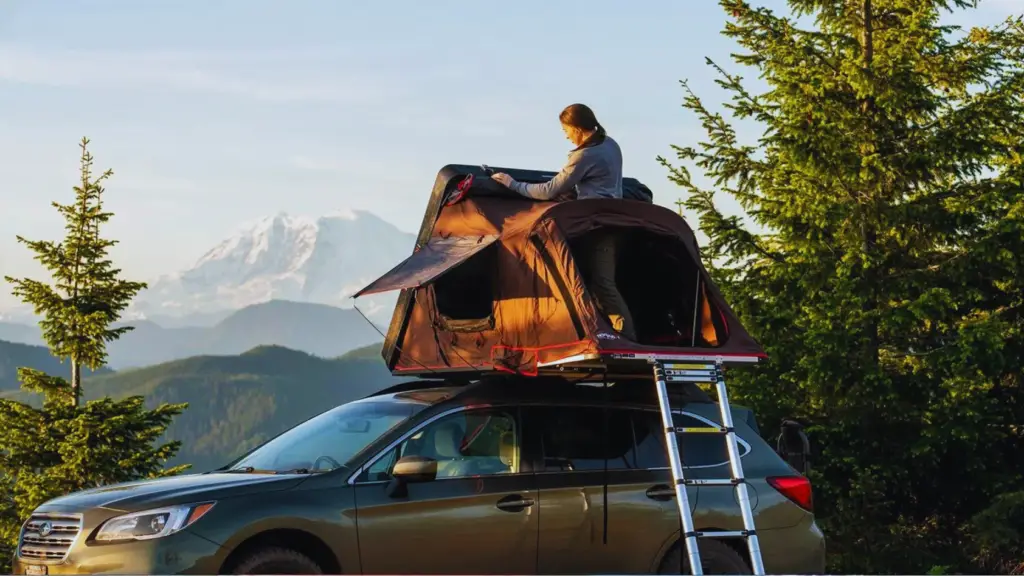
There are two primary categories of rooftop tents:
Hard-Shell RTTs
Hard-shell rooftop tents feature a hard, fiberglass or ABS plastic shell that lifts up or folds out to open. The robust outer shell provides ample standing space and weather protection. Hard shell tents close securely over foam mattresses.
Popular brands like Tepui and Roofnest excel at premium hard shell tent designs in wedge and box shapes. These rigid tents cost more but deliver outstanding performance and livability.
Soft-Shell RTTs
Soft-shell rooftop tents utilize durable canvas stretched over aluminum poles or frames. Most adopt a folding lift-up design that exposes mesh windows and interior access.
Soft shell tents weigh less and offer excellent ventilation. Brands like James Baroud specialize in lightweight soft tops ideal for off-road exploration. They cost slightly less than hard shells.
Both styles have pros and cons depending on your exact camping needs and budget. Test different tent makes and models in person when possible.
Do I Need a Special Vehicle Roof Rack?
In short, yes. Rooftop tents require a roof rack designed specifically to handle their size, weight, and mounting system.
Most quality RTTs weigh 100–200 pounds or more. Add in wind resistance at highway speeds, and you need an ultra-sturdy rack.
The rack must attach tightly to your roof via fixed mounting points. It also needs to match your tent’s mounting bolts and spacing.
Truck bed racks are ideal if camping in a pickup. For other vehicles, choose roof racks made by Front Runner, Rhino-Rack, or ARB. Consult your RTT manufacturer for recommended roof racks and weight limits before purchasing.
Invest in a rack engineered to handle rooftop tents. Off-brand racks risk failure and serious accidents.
How Easy Are Rooftop Tents to Set Up and Close?
One of the best perks of rooftop tents is the ease and speed of opening them from closed to open and vice versa.
With hard shell models, you simply unlock and lift up or fold over the top section to expose the interior space and ladder. For soft tops, unzip the outer canvas and deploy the internal poles or frame.
Opening your rooftop tent should take 1–5 minutes once you get the process down. Closing the tent after use can be even faster. Having quick and easy roof top access is a major benefit for spontaneous roadside camping.
Be sure to practice setting up and breaking down your specific model at home first, so you know what to expect on the road.
How Much Weight Can Rooftop Tents Hold?

It depends on the tent’s specifics, but most quality rooftop tents support around 400–600 pounds of weight. Some ultra-rugged models like Front Runner’s Feather-Lite hold up to 900 pounds!
Keep in mind that the total weight capacity includes all occupants and gear stored inside.
The weight rating should easily accommodate two average-sized adults plus their belongings. But be mindful of overloading if camping with multiple people or heavy equipment. Too much weight risks damaging the tent or your roof.
Consult your owner’s manual for the official weight limits. Keep an eye on sagging roof racks or tents as a sign you may be near the maximum capacity.
Weight of Hard Shell Roof Top Tents
| Brand | Model | Hard Shell Style | Sleeping Capacity | Weight |
|---|---|---|---|---|
| Roofnest | Condor | Clamshell with Fold-Out | 2-3 | 135 lbs |
| Roofnest | Condor XL | Clamshell with Fold-Out | 3-4 | 160 lbs |
| Roofnest | Condor Overland | Clamshell with Fold-Out | 2-3 | 165 lbs |
| Roofnest | Falcon 2 | Clamshell | 2 | 160 lbs |
| Roofnest | Falcon 2 XL | Clamshell | 2-3 | 175 lbs |
| Roofnest | Falcon 2 Pro | Clamshell | 2 | 180 lbs |
| Roofnest | Sparrow | Pop-Up | 2 | 130 lbs |
| Roofnest | Sparrow XL | Pop-Up | 2-3 | 155 lbs |
| Roofnest | Sparrow Adventure | Pop-Up | 2 | 130 lbs |
| Roofnest | Sparrow Adventure XL | Pop-Up | 2-3 | 150 lbs |
| Roofnest | Sparrow EYE | Pop-Up | 2 | 130 lbs |
| iKamper | Skycamp Mini | Clamshell with Fold-Out | 2 | 125 lbs |
| iKamper | Skycamp 3.0 Mini | Clamshell with Fold-Out | 2 | 125 lbs |
| iKamper | Skycamp 2.0 | Clamshell with Fold-Out | 4 | 160 lbs |
| iKamper | Skycamp 3.0 | Clamshell with Fold-Out | 4 | 165 lbs |
| Thule | Basin | Pop-Up | 2 | 176 lbs |
| Thule | Basin Wedge | Clamshell | 2 | 156 lbs |
| SMRT Tent | Summit Suite Tent | Clamshell | 3 | 160 lbs |
| ROAM Adventure Co | Rambler | Pop-Up | 2 | 130 lbs |
| Overland Vehicle Systems | Bushveld | Clamshell with Fold-Out | 4 | 175 lbs |
| Sylvansport | Loft | Pop-Up | 2 | 117 lbs |
Weight of Soft Shell Roof Top Tents
| Brand | Model | Person Capacity | Weight |
|---|---|---|---|
| Front Runner | Roof Top Tent | 2 | 93 lbs |
| iKamper | X-Cover 2.0 Mini | 2 | 119 lbs |
| ikamper | X-Cover 2.0 | 3-4 | 150 lbs |
| Thule | Tepui Foothill | 2 | 122 lbs |
| Thule | Tepui Ruggedized Kukenam | 3 | 162 lbs |
| Thule | Tepui Ruggedized Autana + Annex | 3 | 195 lbs |
| Thule | Tepui Explorer Ayer | 2 | 100 lbs |
| Thule | Tepui Explorer Kukenam | 3 | 119 lbs |
| Thule | Tepui Explorer Autana | 3 | 152 lbs |
| Thule | Tepui Explorer Autana + Annex | 4 | 180 lbs |
| Thule | Tepui Low-Pro 2 | 2 | 98 lbs |
| Thule | Approach Roof Top Tent | 2 | 110 lb |
| SMRT Tent | The Softshell Tent | 4 | 128 lbs |
| Yakima | Skyrise Rooftop | 3 | 115 lbs |
| Yakima | SkyRise HD | 3 | 114 lbs |
| ROAM Adventure Co | Vagabond Lite | 2 | 110 lbs |
| ROAM Adventure Co | Vagabond XL + Annex | 4 | 160 lbs |
| Overland Vehicle Systems | TMBK 3 | 3 | 100 lbs |
Do Roof Tents Damage Cars?
You need not worry about rooftop tent damage if you take two key precautions:
First, only mount your RTT on a robust roof rack designed specifically to handle the tent’s size and weight. Off-brand racks risk failure.
Second, follow the manufacturer’s instructions exactly for attaching the tent to the roof rack. This includes using the recommended bolts and tightening force levels.
As long as you take care to distribute the load appropriately using a sturdy mounting system, your vehicle roof will be just fine holding a tent.
Of course, exercise common sense as well. Don’t take your Jeep rock crawling with a tent atop an inadequate rack! Know the limits of your gear.
How Weatherproof Are Rooftop Tents?
Premium roof top tents utilize waterproof fabrics, sealed seams, and rainfly covers to handle the elements. Hard shell models excel at keeping occupants dry thanks to rigid covers.
But it’s smart to take additional precautions in extreme rain or snow:
- Pitch rainfly fabric at steeper angle to prevent water pooling
- Apply waterproofing sprays to the canvas and seams
- Close all vents, windows and doors tightly
- Add a secondary tarp or pole cover over tent
Avoid opening the tent doors or windows during wet weather. Take care entering and exiting to prevent water intrusion.
With proper care and weatherproofing, you can stay cozy inside a rooftop tent during even the most epic storms!
How Well Do Rooftop Tents Handle Wind?
Between their low-profile shape and secure mounting system, most rooftop tents handle wind surprisingly well. Even in strong gusts, the tents stay locked in place and minimize flapping.
But it’s wise to take extra wind-proofing steps:
- Close the tent completely when unattended to reduce sail effect
- Park your rig perpendicular to wind direction when possible
- Add guy lines from tent corners to solid anchors
- Increase mounting bolt tightness before windstorms
- Install protective wind deflector panels
Avoid leaving the tent open in high winds. The hard shells and hydraulics tend to handle gusts better than canvas soft tops.
Use good judgment, and don’t hesitate to take shelter in your vehicle away from trees if winds become severe.
Will Condensation Be an Issue Inside Rooftop Tents?
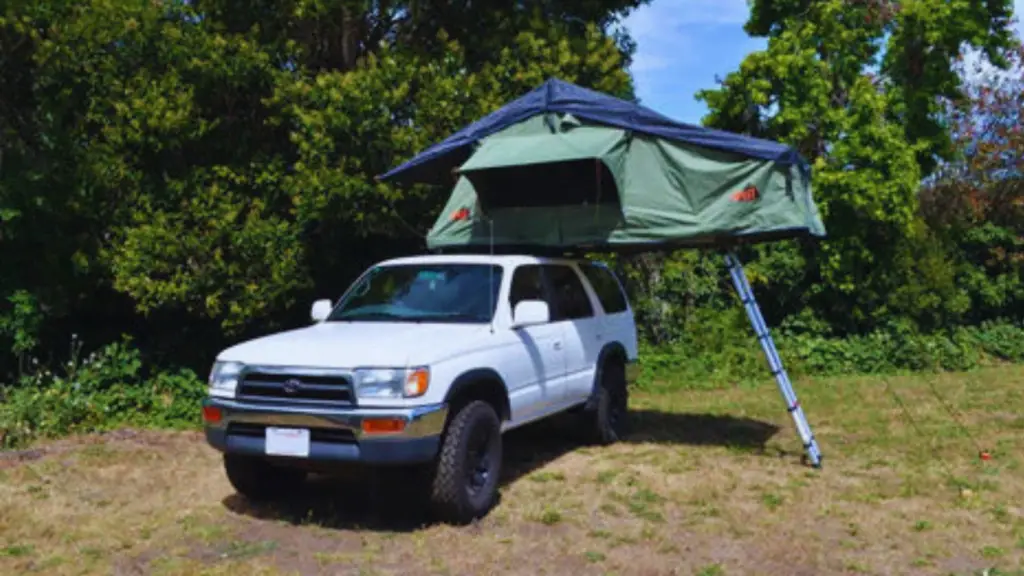
The most significant downside of roof top shelters is interior condensation. The causes include:
- Limited ventilation from full enclosure
- Temperature differential between inside and outside
- Exhaled vapor from sleeping occupants
To minimize condensation:
- Crack windows or doors open when possible
- Use a battery-powered exhaust fan to circulate air
- Wipe down tent walls with an absorbent cloth
- Choose a tent with ample ventilation features
- Insulate cold exterior surfaces that collect moisture
Some interior dampness is expected. Just be diligent about drying out your tent completely after wet trips before stowing.
Do You Need a Roof Rack for a Roof Top Tent?
Yes, you absolutely need a roof rack specifically designed for rooftop tents in order to mount one on your vehicle. Here are some key reasons why a roof rack is required:
- Weight capacity: Rooftop tents weigh 100–200+ lbs. The vehicle roof alone cannot handle that weight, especially when dynamic forces are added at speed. You need a rack robust enough to bear the load.
- Mounting points: There is no way to securely attach a rooftop tent directly to your roof. The rack provides fixed mounting points and rails to bolt through.
- Load distribution: The rack evenly distributes the tent’s weight across roof supports rather than concentrating forces in one spot.
- Lateral stability: During travel, the rack provides critical lateral stability to keep the tent centered and prevent side-to-side shifting or sheer forces.
- Rack height: Most rooftop tents require a certain rack height or clearance above the roof for the clamshell design to open properly.
- Accessibility: The rack’s side rails facilitate getting gear in and out of the tent. Without a rack, accessibility would be very limited.
In short, a burly roof rack engineered specifically for rooftop tents is mandatory. Don’t even think about mounting an RTT directly to a naked roof; it’s risky, and the tent would not open or close properly anyway. Invest in a rack like FrontRunner or Rhino-Rack before purchasing your rooftop tent for a secure and seamless setup.
Do Roof Top Tents Come with Mattress?
Whether or not a roof top tent (RTT) comes with a mattress can vary depending on the specific model and manufacturer. Here are some key points about mattresses and RTTs:
- Most basic RTT models do not include a mattress. The interior space will be empty and a mattress must be purchased separately.
- Higher-end RTTs, especially those in the mid-range in price, often do include a built-in mattress or sleeping platform as part of the package. This adds convenience.
- Inflatable mattresses are a popular option for RTT use since they can be easily packed away when the tent is broken down. Many brands offer inflatable mattress options.
- Closed-cell foam mattresses are an alternative that don’t require inflation. But they take up more storage space when not in use.
- It’s a good idea to have a mattress liner or sleeping pad underneath any RTT mattress for insulation and padding from the hard top surface.
- Additional sleeping pads can be used to increase comfort if the included mattress feels too thin.
So in summary – while the basic models often don’t include one, looking at the specific RTT product page will confirm if a mattress is provided or needs to be purchased separately to complete the setup. An inflatable pad is a versatile choice.
How Do You Install a Roof Top Tent?
Installing a rooftop tent typically involves mounting it onto a roof rack system. The specific installation process may vary depending on the brand and model of the tent, so it’s important to refer to the manufacturer’s instructions for proper installation steps.
Watch this helpful video from Roofnest to learn how to set up your own rooftop tent.
Why are Roof Top Tents (RTT) popping up all over campsites these days?
Roof Top Tents (RTTs) have gained popularity in recent years for several reasons:
- Convenience: RTTs offer a convenient and quick setup compared to traditional ground tents. They can be deployed in a matter of minutes, making them appealing to campers who want to spend more time enjoying the outdoors and less time setting up camp.
- Comfort: Many RTTs come with built-in mattresses and provide a comfortable sleeping experience. Sleeping off the ground can also be more comfortable and safe, especially in areas with wildlife concerns or uneven terrain.
- Elevated Views: Being perched on top of a vehicle provides campers with elevated views of their surroundings, enhancing the camping experience. This vantage point can be particularly appealing in scenic locations.
- Versatility: RTTs can be mounted on a variety of vehicles, including SUVs, trucks, and even some smaller cars. Due to their adaptability, campers are free to explore a variety of locations.
- Weather Resistance: Many RTTs are designed to withstand various weather conditions, including rain and wind. This added protection can make camping more enjoyable and secure, especially in unpredictable weather.
- Space Efficiency: RTTs can free up space inside the vehicle, which can be beneficial for storing gear and supplies. This extra space can make camping trips more organized and comfortable.
- Safety: Being elevated off the ground can provide an additional layer of safety from wildlife encounters, flooding, and other potential hazards. It also provides a level of security against theft and vandalism.
- Trend and Social Media: Social media platforms and outdoor enthusiasts often showcase their RTT setups, creating a trend that encourages others to try them out. The desire to capture unique camping experiences for social media can drive the adoption of RTTs.
- Minimal Environmental Impact: RTTs often have a smaller environmental footprint compared to traditional camping setups, as they don’t require clearing or altering the ground. This appeals to eco-conscious campers.
- Community and Camaraderie: As RTTs become more popular, a sense of community and camaraderie among RTT owners has developed. Sharing experiences, tips, and camping locations with like-minded individuals adds to the appeal of RTTs.
In summary, the surge in popularity of Roof Top Tents can be attributed to their convenience, comfort, versatility, and desire for unique camping experiences, all of which align with the evolving preferences of modern campers.
Do Roof Top Tents Get Hot?
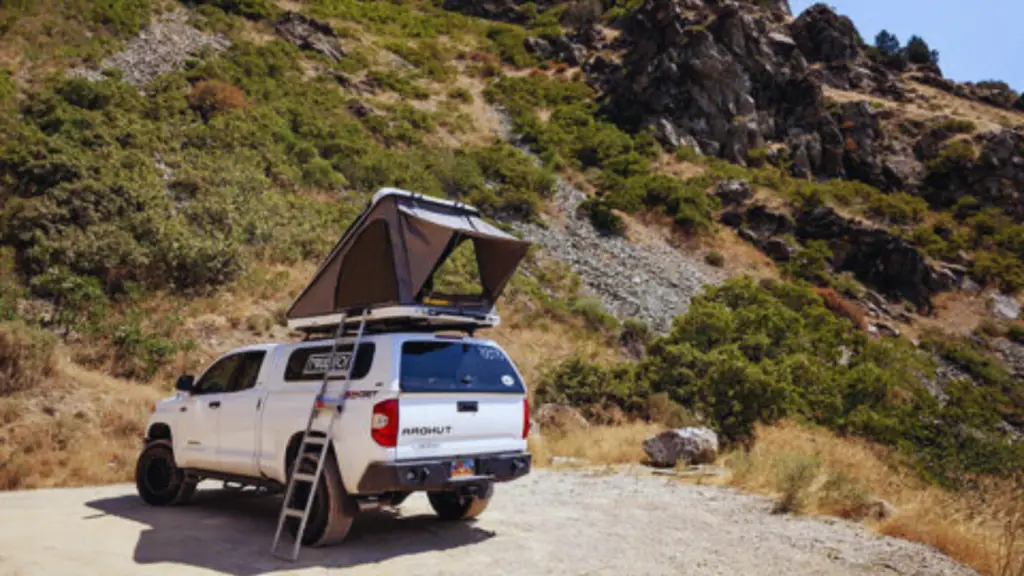
Yes, rooftop tents can get hot, especially in direct sunlight and warmer weather. Here are some of the factors that contribute to rooftop tents heating up and tips to help keep your tent cooler:
- Sun Exposure: Rooftop tents are elevated and exposed to direct sunlight, which can cause significant heat buildup inside the tent during the day. Parking in shade can help.
- Ventilation: Lack of airflow from being fully closed while driving can lead to heat being trapped inside soft-shell tents. Opening vents and windows allows for airflow.
- Shell Materials: Dark-colored shells on hard-shell RTTs tend to absorb and retain more heat than lighter colors.
- Trapped Body Heat: With enclosed spaces and sleeping occupants, body heat gets trapped inside and leads to stuffiness.
- Outside Temperatures: High ambient temperatures make it harder for tent materials to stay cool.
- Near Cooking Areas: Placement near camp stoves radiates additional heat.
- Insulation: While good for cold weather, interior insulation holds heat in during the summer.
Tips for keeping your rooftop tent cooler:
- Seek shade when possible and use reflective sun shields.
- Maximize ventilation and airflow.
- Install battery-powered exhaust fans.
- Avoid cooking near the tent location.
- For hot climates, favor white or light colored shells.
- Use breathable cotton sheets instead of sleeping bags.
- Sleep with roof vents or windows open.
- Remove internal insulation panels during the summer if possible.
With smart precautions, you can stay cooler in your rooftop tent, even on hot, sunny camping days. Proper ventilation is key.
Are Roof Top Tents Easy to Steal?
Roof top tents are not necessarily easy targets for theft. Here are some factors that help keep RTTs secure:
- Weight: Most quality RTTs weigh over 100 lbs. Their bulk makes them difficult to quickly remove and steal.
- Mounting System: RTTs bolt tightly onto roof racks with specialized mounting hardware that takes time and tools to dismantle.
- Vehicle Access – The height of RTTs on roof racks makes them hard to reach and detach without a ladder.
- Locking Mechanisms: Many RTTs have secure locks on zippers and shells to prevent unauthorized access.
- Alarm Systems: Some owners wire RTTs to the vehicle alarm system or install separate anti-theft alarms.
- Visibility: Sleeping occupants have an elevated vantage point to spot any tampering with the vehicle or tent below.
- Off-Grid Locations: RTTs are often camped in very remote spots away from potential thieves.
However, it’s still smart to take precautions:
- Keep valuables out of sight in the vehicle cab, not the tent.
- Park in well-lit areas when possible and use a wheel lock.
- Scope out camp spots thoroughly; move on if you see suspicious activity.
- Use locking straps over zippers when the tent is unattended.
With basic security awareness, rooftop tents do not attract much criminal attention compared to vehicle break-ins. But always trust your instincts if somewhere seems unsafe.
How Can I Make My Roof Top Tent More Comfortable?
Yes, roof top tents can be very comfortable. They typically come with a foam mattress or bedding inside the tent to provide a cozy sleeping surface. Additionally, being off the ground can provide added comfort and insulation.
Here are some tips to make your rooftop tent more comfortable:
- Add cushioning: Use a thick self-inflating sleeping pad or mattress topper for padding.
- Insulate: Line the tent floor with interlocking foam mats or insulation to prevent heat loss.
- Bedding: Invest in warm, breathable bedding like wool blankets or down comforters.
- Pillows: Bring along plush, supportive pillows. Inflatables are best for packing.
- Lighting: Install battery-powered rope lights or lanterns for ambiance at night.
- Ventilation: Use a portable fan for airflow and to reduce condensation and stuffiness.
- Power: Connect a portable power station to charge devices and run accessories.
- Organization: Install pockets, hooks, and shelves to keep gear tidy and close at hand.
- Privacy: Use window shades or curtains to darken the interior in the morning.
- Entryway: Add a doormat and shoe organizer in the entryway.
- Seating: Bring a collapsible tripod camp stool or chair for lounging.
- Weather protection: Use a tarp or sun shade above the tent for added protection.
With thoughtful additions and upgrades, you can customize your rooftop tent into a cozy home away from home. Focus on quality sleep and deluxe touches to live in luxury on rugged adventures!
Options for Pickup Camper Conversions
Here are some popular options for converting your pickup truck into a camper:
Truck Bed Campers
A hard-sided camper shell that fits into your truck bed. Provides sleeping space, storage, and some amenities. Easy to install but limited space. Top brands are A.R.E., LEER, and Access.
Truck Toppers
Similar to campers but without interior amenities or sides. adds a covered cargo area. Budget-friendly starting point for camping from a truck.
Slide-in Campers
Larger hard-sided units that slide between your truck’s cab and bed. Some models offer stand-up entries with a full kitchen, bathroom. More amenities but reduced cargo capacity. Examples are Adventure Campers, Lance Campers.
Pull-Behind Campers
Recreational park trailers are towed behind your truck. Separate from the truck, so both can be used independently. More living space inside. Require towing package on the truck. Jayco, Dutchmen, and Starcraft are leaders.
Overland Campers
High-clearance overland trailers with robust off-road capability. Mounted rooftop tents are also an option. For serious off-grid exploration. Match truck power to trailer weight. Examples: Tracker, ARB, CRVFAB.
Research what features you need along with truck payload capacity before choosing a pickup camper option. Converting your truck expands your camping adventures.
Can You Leave Bedding in a Roof Top Tent?

Here are some tips on leaving bedding in a rooftop tent between uses:
- Avoid leaving sleeping bags rolled up when stored damp – this can lead to mold and mildew. Air them out fully first.
- Down or synthetic insulated bedding is fine left inside the tent between trips. Just be sure it stays dry.
- Make sure cotton, linen, or wool sheets and blankets are completely dry before packing them away in the closed tent.
- Use a waterproof mattress cover or encasement to protect the sleeping surface from moisture.
- Place moisture-absorbing silica gel packs in the tent to prevent dampness when closed up.
- Consider using sleeping bag liners instead of stuffing bags – they take up less space when stored.
- Remove pillows when not in use so they can dry out fully at home between trips.
- Check that all zippers and closures seal tightly so no water leaks in while the tent is shut.
- Air out the tent thoroughly at home after trips before storing bedding inside again.
With some periodic maintenance and moisture control, you can safely leave bedding packed neatly inside a rooftop tent between adventures. Just take care to prevent mildew by keeping items dry.
Comparison Table of Roof Top Tent Manufacturers
Creating a comprehensive comparison table of rooftop tent manufacturers is a substantial task, as there are numerous manufacturers with various models and features. However, we can provide you with a simplified sample comparison table to get you started. Please note that you should conduct further research to gather specific and up-to-date information for your needs.
Here’s a basic comparison table of some of the best roof top tent manufacturers:
| Manufacturer | Model | Sleep Capacity | Setup Time | Weight (lbs) | Material | Price Range | Additional Features |
|---|---|---|---|---|---|---|---|
| Tepui | Explorer Series | 2-4 | 10-15 mins | 100-150 | Ripstop fabric | $1,200 – $2,000 | Annex room, awning |
| Yakima | Skyrise | 2 | 5-10 mins | 115-150 | 210D nylon/poly | $1,000 – $1,400 | Mesh windows, gear storage |
| Thule | Tepui HyBox | 2-3 | 5-10 mins | 150-170 | ABS shell | $1,700 – $2,200 | Dual-purpose (tent/box) |
| iKamper | Skycamp 2.0 | 2-4 | 10-15 mins | 150-220 | Polyester/Cotton | $3,000 – $3,800 | King-size mattress, hardshell |
| Roofnest | Sparrow | 2-3 | 5-10 mins | 135-155 | Fiberglass shell | $2,000 – $2,500 | Gas struts, ladder |
| Smittybilt | Overlander | 2-3 | 10-15 mins | 116-132 | 600D polyester | $900 – $1,100 | Built-in mattress, telescoping ladder |
| Maggiolina | Columbus | 2-3 | 10-15 mins | 132-165 | Fiberglass shell | $3,000 – $3,500 | Aerodynamic design, wide windows |
Gear and Equipment for Rooftop Tents
When it comes to rooftop tents, there are several gear and equipment options that can enhance your camping experience. Here are some commonly used items:
- Roof Rack: A sturdy roof rack is essential for securely mounting and supporting your rooftop tent on your vehicle. Ensure the roof rack is compatible with your specific vehicle and capable of handling the weight of the tent.
- Awning or Shade Shelter: An awning or shade shelter provides additional outdoor living space next to your rooftop tent. It offers protection from the sun, rain, or wind, allowing you to relax or cook outside comfortably.
- Bedding and Sleeping Gear: Invest in comfortable bedding, such as sleeping bags or camping mattresses, to ensure a good night’s sleep. Pillows, blankets, and sheets can also enhance your sleeping arrangements.
- Lighting: Portable LED lights or lanterns are useful for illuminating your campsite at night. They provide adequate visibility inside the tent and around the camping area.
- Camp Chairs and Table: Folding camp chairs and a compact camping table are handy for creating a comfortable seating and dining area outside your tent.
- Kitchen Setup: Consider a portable camping stove, cookware, and utensils for preparing meals. A cooler or portable fridge can help keep your food and drinks fresh during your camping trip.
- Storage Solutions: Use storage containers or bags to keep your gear organized inside the rooftop tent. This will help maximize space and ensure easy access to your belongings.
- Tools and Repair Kit: Pack a basic toolkit and a repair kit that includes items like a multi-tool, duct tape, spare tent poles, and any necessary hardware for quick fixes or adjustments.
- Safety Equipment: Don’t forget essentials like a first aid kit, fire extinguisher, and emergency supplies. Additionally, consider bringing a camping-friendly fire pit or grill for cooking and warmth.
Remember to consider the weight and storage limitations of your rooftop tent and vehicle when selecting gear and equipment. Prioritize items that are compact, lightweight, and durable to optimize your rooftop camping experience.
Roof Top Tent Questions And Answers Conclusion
In summary, our Roof Top Tent Questions and Answers guide serves as a valuable resource for anyone seeking information and clarity about roof top tents. With comprehensive answers to common inquiries, expert advice, and practical tips, you can make well-informed decisions and have a hassle-free camping experience. Whether you’re a seasoned camper or a beginner, our guide is designed to provide the knowledge you need to confidently embark on your next outdoor adventure with a roof top tent. Explore the Q&A section and unlock the insights that will enhance your camping journey.




